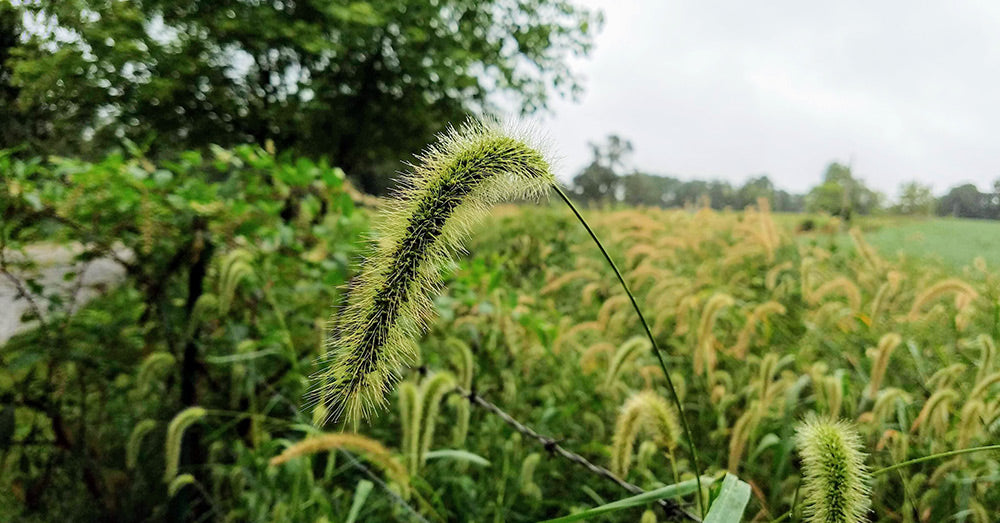Everything You Need To Know About Protecting Your Pet From Foxtail Grass
Matthew Russell
Responsible pet parents understand the importance of giving their dogs outdoor playtime, but Foxtail grasses could make it difficult this summer.
Prevalent in the Western United States, the seed awnings of foxtail grass are barbed. They stick into fur and skin, and sometimes even require the help of a veterinarian to remove.
According to Nancy Kenos, writing for the Whole Dog Journal, "In California, where I have spent all but one year of my life (so far) with dogs, there are two types of dog owners: those have spent a small fortune having veterinarians remove foxtails from some part of their dogs’ bodies, and those who haven’t – yet. I’m in the first group, and I would hazard a guess that the first group is far larger than the second."
 Source: Pexels
Source: PexelsFoxtail grass grows lush and green in the spring.
Here are a few tips on dealing with foxtail grass, and keeping your pet safe from it.
How to spot foxtail grass
Once foxtail grasses have sprung up, Seattle Dog Spot reports, their bright green seeds cling to delicate stalks, much like wheat berries. The seeds are held closely together at first, but as warm summer weather dries the plant, they fan out and fall to the ground.
This is when the foxtail grasses pose the biggest threat.
The barbed seeds are easily picked up by pet paws and fur, and can work their way into sensitive areas, like your pet's nose and eyes.
 Source: Pixabay
Source: PixabayFoxtail grasses grow predominantly in the western United States.
Where does foxtail grass grow?
There are several species of foxtail grasses in North America, but Hordeum murinum and Hordeum marinum are the two you need to look out for.
Unlike Hordeum brachyantherum, a foxtail plant found all over western North America, and Hordeum jubatum, which can be found in the United States and Canada, H. murinum and H. marinum is prevalent in the western U.S., particularly on the West Coast.
According to the Whole Dog Journal, foxtail grass grows throughout California, Oregon, and Washington, in pastures and lawns, driveways and even cracks in the sidewalk.
 Source: Pexels
Source: PexelsSerious cases of foxtail infection can lead to death.
What does Foxtail grass do to pets?
Dogs suffering from foxtail grass awn penetration may appear to have an infection. Symptoms include:
- lethargy
- loss of appetite
- painful swellings
- signs of drainage
Severe cases can be much worse. According to WebMD, "Embedded foxtails can cause discharge, abscesses, swelling, pain, and death."
 Source: flickr/born1945
Source: flickr/born1945Prevention isn't always possible. Keep your pet clear of foxtail infection by grooming their fur with a fine-toothed comb.
What to do if your pet has been in foxtail grass
Preventing your pet from getting stuck with foxtail seeds may be harder than it sounds, so your best approach to avoiding unnecessary pain and suffering may occur after it's happened.
After your pet has finished playing outside, check their fur for foxtails and groom them with a fine-toothed comb. You can remove the burrs with a pair of tweezers or your fingers.
According to Preventative Vet, "If you can’t easily remove the foxtail, or if your dog or cat is exhibiting any of the signs that could be related to the presence of an embedded or inhaled foxtail, see your veterinarian right away. Embedded foxtails can be extremely painful and can cause some very (very) significant damage, too! Your vet will be able to properly manage your dog’s discomfort and deal with the foxtail before the problem gets even worse."
 Source: Pixabay
Source: PixabayIt can be a challenge to prevent foxtail infections without constant vigilance.
How to protect your pet from foxtail grass infection
There are few precautions you can take to fully prevent your pet from getting into foxtails, but knowing where to look will save you frustration, and a potentially high vet bill.
As WebMD reports, foxtails most commonly find their way into the following nooks and crannies:
- Feet - Foxtails can get embedded between your pet's toes quite easily. If your animal's feet are swollen, or if it is limping or licking that area, it may be hiding foxtails there.
- Ears - Foxtails in the ear may prompt your pet to shake its head, tilt it to the side, or scratch them raw. Foxtail seeds can become embedded into the ear canal where you can't typically see without a veterinarian's help.
- Eyes - If your pet's eyes become red, filled with discharge, swell up, or cause the animal to squint and scratch, they may be infected with foxtail fibers. This is a serious issue, and you should visit a veterinarian immediately.
- Nose - Foxtails in the nose are most commonly followed by discharge or constant sneezing. If you can dislodge the seeds from your pets nasal passages, you may solve the problem. If you can't, see a vet.
- Genitals - Foxtails have a way of working themselves into a pet's most sensitive areas, and the genitals are no exception. If your animal begins licking their genitals (more than usual) after some play time outside, they may be alerting you to a foxtail infection.
 Source: Pexels
Source: PexelsIf you think your pet has a foxtail infection, see a veterinarian!
Now that you know what to do, don't let those frustrating foxtails keep you or your pet from enjoying the outdoors. Animals need exercise every day. Be vigilant, and you'll keep those pets happy and healthy!
Additional Resources
- Dog Allergies Guide
- Why Is My Dog So Itchy?
- Ear Mites: Are These Unseen Critters Causing Your Dog’s Itching?
- How To Spot Dog Fleas, Find Relief, And Rid Your Itchy Dog Of Fleas For Good
- Hot Spots: What Causes Them And How To Get Rid Of Them
- Is A Hormonal Imbalance Causing My Dog’s Itchy Skin?
- How Much Benadryl Can I Give My Dog?
- Dry Skin On Dogs: What Causes It And How To Treat It
- Anxiety In Dogs: How To Calm Your Anxious Dog (And Improve His Bad Behavior)

 Source:
Source: 